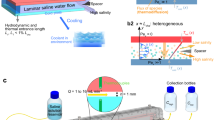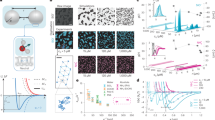Abstract
IN a gas-liquid chromatographic column the assumption of equilibrium demands that the rate constants for solute transfer between the gas and the liquid phases must be infinitely large and the flow-rates extremely small. In practical columns neither of these conditions is ever fulfilled; the kinetic rate constants are finite, and the use of extremely slow flow-rates is out of the question because of undesirably long retention times and pronounced longitudinal diffusion in the gas phase which enhances band broadening. This has led various workers to advance theories which take account of the effect of non-equilibrium conditions on band structure and column efficiencies1–4. Of particular importance is the van Deemter theory4, which uses the driving force concept to describe the departure from equilibrium in terms of resistances to mass transfer in the gas and the liquid phases. The hypothesis of interfacial equilibrium involved in the theory is one the validity of which cannot be demonstrated directly by experiment. The existence of equilibrium at the interface would mean that if the concentration in the liquid phase at the interface is specified, the concentration in the gas phase at the interface is the same as if the two phases had been in contact for an indefinite length of time. Owing to continuous flow of carrier gas it is scarcely likely that the molecules once evaporated from the surface will get to the same spot again, and this, obviously, introduces conceptual difficulties regarding the nature of dynamic equilibrium at any point within the column. A natural consequence of the assumption of interfacial equilibrium is that once the diffusing molecules strike the interface, they pass into the other phase without experiencing any resistance at the interface itself. On the contrary, discrepancies between the calculated and observed rates of absorption suggest that there should be resistance to mass transfer at the interface5–7. From the point of view of the theory of absolute reaction-rates, there are sound theoretical grounds for postulating the existence of interfacial resistance. One can imagine an energy barrier which may involve the formation of an ‘intermediate-activated state’; of all the molecules which strike the boundary surface only those which have the required energy of activation for diffusion surmount the energy barrier while the rest rebound into the gas phase, and furthermore the orientation of molecules may play a part.
This is a preview of subscription content, access via your institution
Access options
Subscribe to this journal
Receive 51 print issues and online access
$199.00 per year
only $3.90 per issue
Buy this article
- Purchase on Springer Link
- Instant access to full article PDF
Prices may be subject to local taxes which are calculated during checkout
Similar content being viewed by others
References
Glueckauf, E., and Coates, J. I., J. Chem. Soc., 1315 (1947).
Lapidus, L., and Amundson, N. R., J. Phys. Chem., 56, 984 (1952).
Glueckauf, E., Trans. Farad. Soc., 51, 34 (1955).
van Deemter, J. J., Zuiderweg, F. J., and Klinkenberg, A., Chem. Eng. Sci., 5, 271 (1956).
Emmert, R. E., and Pigford, R. L., Chem. Eng. Prog., 50, 87 (1954).
Danckwerts, P. V., and Kennedy, A. M., Inst. Chem. Eng., Symp. on Gas Absorption (1954).
Vivian, J. E., and Peaceman, D. W., Amer. Inst. Chem. Eng., 2, 437 (1956).
Author information
Authors and Affiliations
Rights and permissions
About this article
Cite this article
KHAN, M. Non-Equilibrium Theory of Gas-Liquid Chromatography. Nature 186, 800–801 (1960). https://doi.org/10.1038/186800a0
Issue Date:
DOI: https://doi.org/10.1038/186800a0
This article is cited by
-
A test of the theory of zone spreading in capillary chromatography and an estimate of the contribution CF the resistance to mass transfer at the gas-liquid boundary
Bulletin of the Academy of Sciences of the USSR Division of Chemical Science (1980)
-
The adsorption effects in gas-liquid chromatography on columns with mixed stationary gases
Bulletin of the Academy of Sciences of the USSR Division of Chemical Science (1971)
-
Gas Chromatography
Nature (1961)
Comments
By submitting a comment you agree to abide by our Terms and Community Guidelines. If you find something abusive or that does not comply with our terms or guidelines please flag it as inappropriate.



